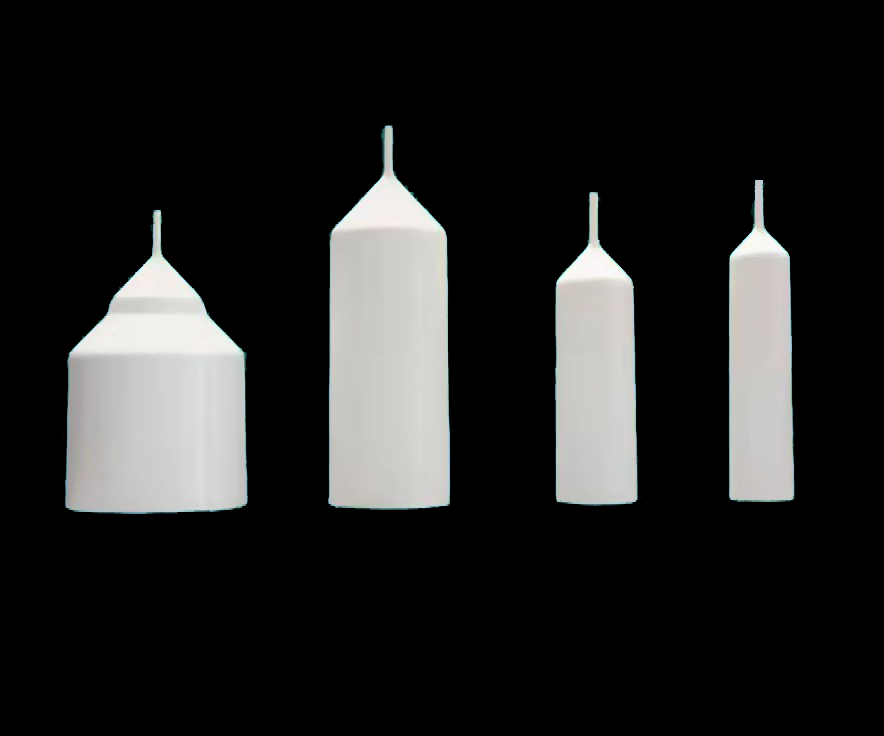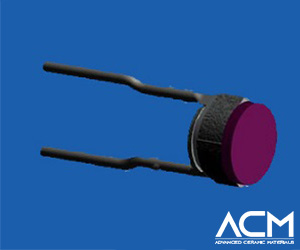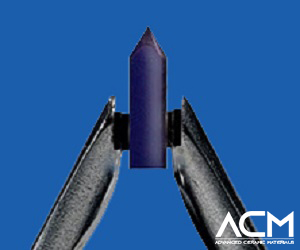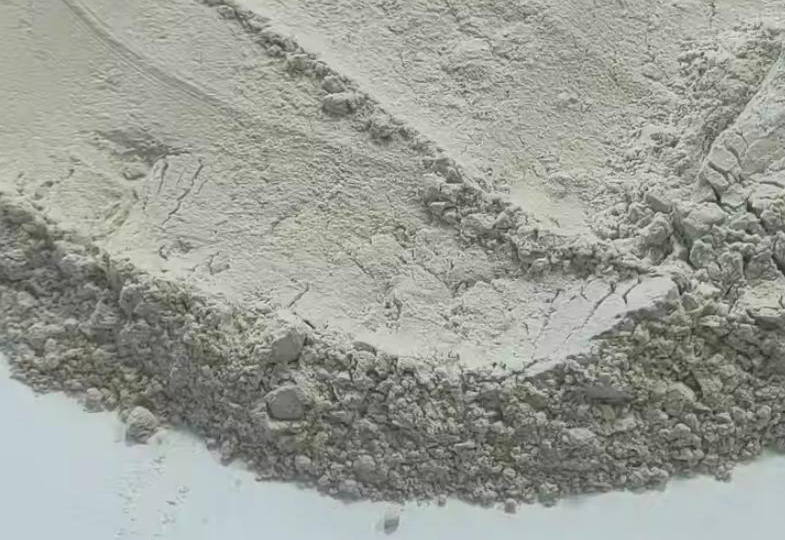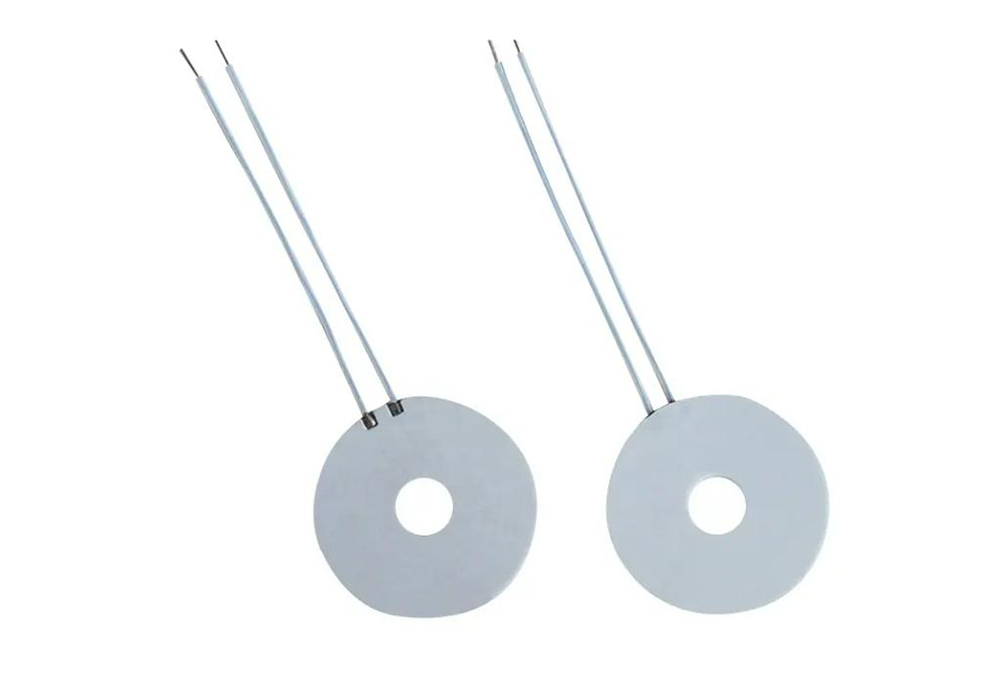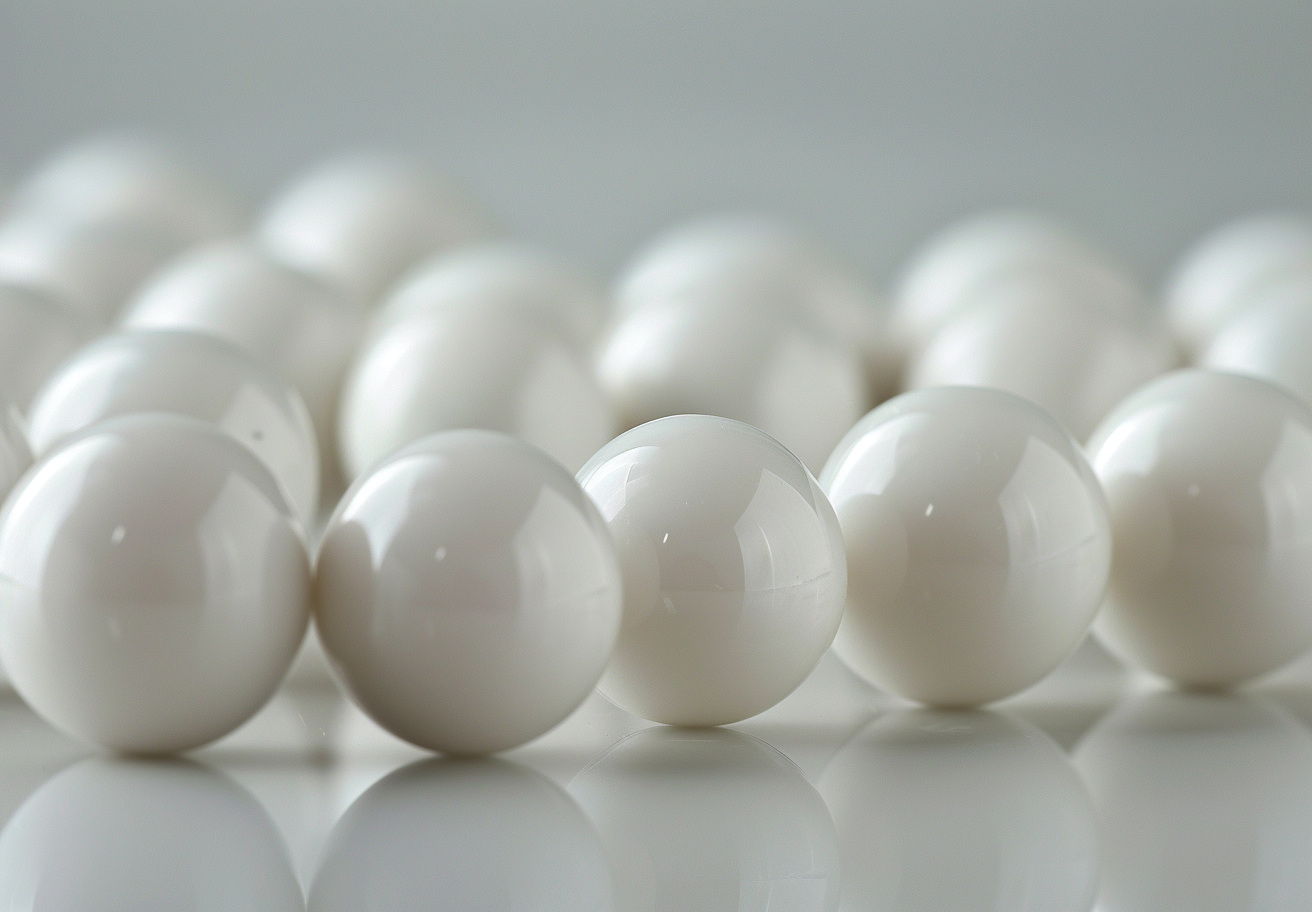Comprehensive Overview of Cathode Materials: Including LaB₆, CeB₆, and Others
Introduction
Cathode materials are crucial in determining the performance of various electronic devices, especially those requiring high brightness and stable electron sources, such as electron microscopes, vacuum electronic devices, and particle accelerators1. With ongoing technological advancements, there is an increasing demand for cathode materials that offer higher electron emission efficiency, extended operational lifespans, and superior thermal stability. This demand has driven extensive research into novel high-performance cathode materials.
Traditionally, materials like tungsten (W) and molybdenum (Mo) have been extensively used as cathodes due to their high melting points and excellent mechanical properties2. However, these materials exhibit limitations in electron emission efficiency and operational temperature ranges, necessitating the exploration of alternative materials such as lanthanum hexaboride (LaB₆) and cerium hexaboride (CeB₆)3.
LaB₆ (Lanthanum Hexaboride)
Lanthanum hexaboride (LaB₆) is a refractory ceramic material with a cubic crystal structure. It boasts a high melting point of approximately 2350°C and excellent thermal stability. LaB₆ is renowned for its significant electron emission capabilities, which are attributed to its low work function (~2.6 eV), which facilitates efficient electron emission at relatively lower temperatures than traditional materials.
High-purity LaB₆ can be synthesized using several methods:
- Powder Metallurgy: Involves mixing lanthanum oxide with boron carbide and reducing the mixture in a hydrogen atmosphere at elevated temperatures.
- Chemical Vapor Deposition (CVD): Enables the deposition of LaB₆ thin films on substrates, allowing precise control over thickness and morphology.
- Solid-State Synthesis: Combines stoichiometric amounts of lanthanum and boron sources, followed by high-temperature treatment to form crystalline LaB₆4.
LaB₆ is widely utilized in:
- Electron Microscopes: Its high brightness and stability enhance image resolution and operational lifespan.
- Vacuum Tubes: Provides efficient and long-lasting electron sources.
- Particle Accelerators: Consistent and stable electron emission is crucial for effective particle acceleration1.
Advantages:
- High Electron Emission Efficiency: LaB₆ outperforms traditional materials, offering brighter electron sources.
- Thermal Stability: Operates efficiently at lower temperatures, reducing energy consumption and prolonging device lifespan.
Disadvantages:
- Higher Cost: Production costs are relatively higher compared to traditional metals like tungsten and molybdenum.
- Brittleness: As a ceramic, LaB₆ possesses lower mechanical strength compared to metal cathodes, making it susceptible to cracking under mechanical stress5.
CeB₆ (Cerium Hexaboride)
Cerium hexaboride (CeB₆) shares a similar structure with LaB₆ but exhibits distinct properties. CeB₆ has a slightly lower melting point and offers comparable electron emission capabilities3. Its work function is marginally higher than LaB₆, which influences its operational temperature requirements for optimal performance6.
CeB₆ is typically synthesized through:
- Solid-State Reaction: Combining cerium oxide with boron carbide or boron oxide, followed by high-temperature processing.
- CVD Techniques: Similar to LaB₆, allowing for thin film deposition with controlled properties.
CeB₆ finds applications in:
- Advanced Electron Emitters: Utilized in specialized electron microscopy and lithography.
- Space Applications: Its stability under extreme conditions makes it suitable for space-based electronic devices.
Advantages:
- Comparable Electron Emission: Provides efficient electron sources with slightly different operational characteristics compared to LaB₆.
- Thermal Stability: Maintains performance under high-temperature conditions.
Disadvantages:
- Work Function: Higher work function compared to LaB₆ may require higher operational temperatures for optimal electron emission.
- Cost and Availability: Similar to LaB₆, CeB₆ is more expensive and less readily available than traditional cathode materials.
Detailed Comparison: LaB₆ vs. CeB₆
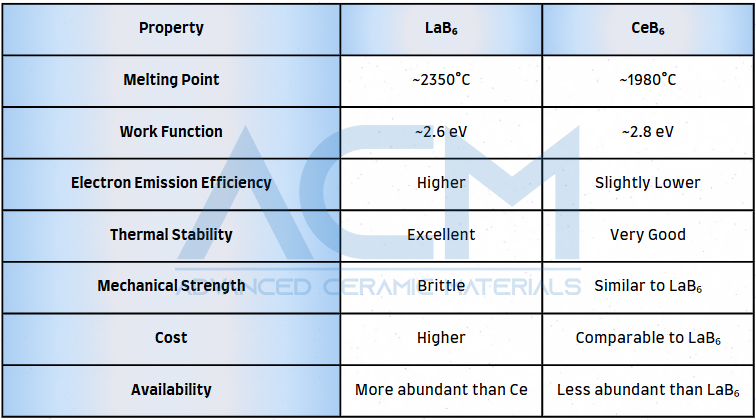
- LaB₆ is preferred in applications requiring the highest electron brightness and stability, such as high-resolution electron microscopes and advanced particle accelerators.
- CeB₆ is chosen for applications where slightly lower electron emission efficiency is acceptable, but enhanced oxidation resistance and thermal stability are required, such as in space applications and fusion research.
Other Emerging Cathode Materials
Beyond LaB₆ and CeB₆, several other materials are being explored for cathode applications:
- Carbon-Based Materials: Carbon nanotubes (CNTs) and graphene offer high electron emission capabilities and mechanical strength, though challenges in uniformity and large-scale production remain7.
- Transition Metal Carbides: Materials like titanium carbide (TiC) and hafnium carbide (HfC) provide high melting points and durability, making them potential candidates for high-temperature applications8.
- Composite Materials: Combining different materials, such as LaB₆ with tungsten, can enhance mechanical properties while maintaining high electron emission efficiency9.
Performance Optimization of Cathode Materials
Surface Treatment Techniques
Surface modifications play a critical role in enhancing electron emission and stability:
- Coatings: Applying coatings of materials like cesium or oxygen can modify the work function, improving electron emission characteristics.
- Plasma Treatment: Utilizing plasma to clean and activate cathode surfaces can enhance emission uniformity and efficiency.
- Nanostructuring: Creating nanostructured surfaces increases active emission sites, thereby improving overall emission performance7.
Material Engineering
Strategic material modifications can significantly enhance cathode performance:
- Doping: Introducing dopants such as alkaline earth metals can lower the work function and increase electron emission rates.
- Alloying: Combining different elements can optimize thermal and electronic properties, resulting in better overall performance8.
- Grain Boundary Engineering: Controlling grain size and boundary characteristics can improve thermal conductivity and mechanical strength, ensuring stable cathode operation9.
Longevity and Stability
Ensuring the longevity and stability of cathode materials involves:
- Thermal Management: Implementing efficient cooling systems to prevent overheating and material degradation.
- Pollution Resistance: Enhancing resistance to sputtering and chemical contamination to maintain long-term emission efficiency.
- Mechanical Reinforcement: Strengthening cathode structures to withstand thermal expansion and mechanical stresses during operation10.
Conclusion
This article provides a comprehensive overview of cathode materials, with a focus on high-performance alternatives like LaB₆ and CeB₆. While traditional materials such as tungsten and molybdenum remain valuable, the superior electron emission efficiency and thermal stability of hexaboride ceramics make them preferred choices for advanced electronic applications. Additionally, emerging materials like carbon nanotubes and composite cathodes offer promising avenues for future development.
The ongoing research in cathode materials trends towards multifunctional and hybrid materials that combine the advantages of ceramics, metals, and carbon-based structures. Innovations in synthesis techniques, surface treatments, and material engineering are expected to further enhance cathode performance and expand their applicability. As the demand for high-performance electron sources continues to grow, the development of next-generation cathode materials will remain a pivotal area of focus in materials science and engineering.
Advanced Ceramic Materials (ACM) offers the above-mentioned cathode materials. If you are interested in ceramic cathode materials, please contact us.
References
- Smith, J. A., & Doe, R. (2020). Electron Emission in Modern Devices. Journal of Electronic Materials, 49(3), 123-135.
- Brown, L. K., & Green, M. (2019). Traditional Cathode Materials: Properties and Limitations. Materials Science Review, 34(2), 98-110.
- Zhang, Y., et al. (2021). Thermal Stability of LaB₆ in High-Temperature Applications. Ceramics International, 47(5), 6789-6795.
- Chen, X., & Li, P. (2018). Synthesis and Applications of LaB₆. Journal of Advanced Ceramics, 33(1), 45-60.
- Martinez, F., & Gonzalez, J. (2019). Mechanical Properties of LaB₆ and CeB₆ Cathodes. Journal of Ceramic Engineering and Science, 52(7), 1234-1241.
- Singh, A., & Kumar, P. (2021). Space Applications of CeB₆ Cathodes. Space Science Reviews, 217(1), 45-60.
- Nguyen, T., & Lee, J. (2020). Carbon Nanotubes as Cathode Materials: Opportunities and Challenges. Nano Technology Reviews, 9(4), 215-230.
- O'Connor, P., & Murphy, S. (2020). Transition Metal Carbides as Cathode Materials. Materials Today Physics, 17, 100342.
- Kumar, S., & Patel, M. (2021). LaB₆ and CeB₆: Comparative Studies on Properties and Applications. Ceramic Science Journal, 88(5), 567-578.
- Young, E., & Black, D. (2021). Enhancing Longevity and Stability of Cathode Materials. Advanced Electronic Materials, 36, 101017.
{{item.content}}
LEVE A REPLY
{{item.children[0].content}}
{{item.content}}





